The Crown of the Holy Roman Empire also known as the Crown of Charlemagne was made in the 2nd half of the 10th century and now resides in Vienna at the Schatzkammer Museum of Art History. Originally set with various precious gems including the most legendary stone of Medieval Europe the ‘Orphanus’ Opal as referred to by Albertus Magnus.

“They gleam at each other; the noble stone and the sweet young man, a feast for every princely eye. Those still doubting who embodies the realm may now see on whose head the topstone stands! This stone is the lodestar of all princes.” Walter von der Vogelweide, 1198.
Dubbed the ‘Stone of wisdom’ it was thought to represent the chosen of God and to the Hohenstaufen thinking incorporated all the virtues and symbolised Christ himself. The translucent white opal with an intense red flash glowed in the dark. Around 1350 under the reign of Charles IV the Orphanus disappeared from the front panel of the crown.

Imperial Russian Crown 
Saint Foy
The Russian Imperial Crown c.962 AD, containing Hungarian Opals is also on view at the Vienna Schatzkammer Museum in Austria.
This reliquary statue of Lady St Foy at Conques in France dates to the late 10th century. She is a wooden figure covered with sheets of gold and silver, wearing a crown and earrings decorated with granulation and filigree. Her bodice is set with numerous stones; cameos, pearls and gems. The gems including Opals are uncut stones typical of the Middle Ages.

Sir Bevil Grenville 
The Grenville jewel
The ‘Grenville’ Jewel (English c.1635-40). A richly enamelled gold locket containing the miniature portrait by David Des Granges (signed DDG) of the Royalist hero, Sir Bevil Grenville (1596-1643), who was killed whilst leading the Cornish army at the Battle of Lansdown, near Bath. The jewel mentioned in his widow’s will in 1647, remained in the family until the late 19th century. This exquisite rarity offers sound evidence of English court taste on the eve of the Civil War. Interestingly the piece is interspersed with emeralds, rubies and diamonds in rubbed-in settings, but the Opals are claw set to allow light through them.

The Sun Jewel pictured was worn by the British maritime hero Sir Francis Drake (1543-1596). At the centre of this hat jewel is a ruby engraved with an intaglio orb, surrounded by Opals within a diamond and Opal border.This is framed by straight and curved rays alternately enameled red and set with rubies. On the back of the jewel is a miniature of Elizabeth I of England (1533-1603). The orb, which is emblematic of sovereignty, may allude to Elizabeth, or to Drake’s historic circumnavigation of the world. The jewel has four loops for attachment to a hat. In total it contains twenty Opals which were much in fashion in England after 1573.

This jewelled pendant is crowned by 5 crystal Opals. A white hand grasping a laurel wreath is flanked by dragons emerging from cornucopiae all framing a crystal reliquary containing a curl of Queen Mary’s dark brown hair.
Mary Stuart Queen of Scots (1542-1587), though she has not been canonised by the Catholic Church, many consider her a martyr, and there are relics of her. The pendant was a gift by Queen Mary to one of her closest supporters James Gordon ancestor of the Earls & Marquesses of Aberdeen. Ever since it has been worn by the reigning Marchioness of Aberdeen.

This lapis lazuli drinking cup sits on a stem formed by two gold dragons with Fire Opal eyes, four dolphins and a white enamelled putto. It forms part of a collection of ceremonial vessels in the treasure of the Grand Dauphin – Louis of Bourbon (1661-1711). On display at the Prado Gallery in Madrid it is reputedly the work of the Saracchi brothers, circa.1600.
This piece is important as a rare early example of the use of Opal from the newly discovered American continent.

Countess Elizabeth of Exeter (1681-1723) wore this ‘Dragonfly’ pin in her hair. Most likely made by a local jeweller, set with cabochon Opals, rubies, garnets and diamonds, it is enamelled on the reverse. This lovely piece now resides in the Museum of London.
Also in London, a very Black Opal of 131 carats is exhibited at the Natural History Museum.

Opaline Vinaigrette; A jewelled vessel for scented vinegar (formerly used by ladies to ward off faintness). Gold receptacle and chain, furnished with Opals and opalines, white enamel, diamonds, ruby spinels, pink sapphire; 5,6 cm. France (Paris), beginning of the 17th Century. © Museum of London.

This attractive necklace of Opals mounted in brilliants originally belonged to the Maréchale de Rochambeau. Made towards the end of the eighteenth century it is exemplary of the care and attention given to mounting Opals; imitation Opals were also made but usually in pinks and mauves which are unknown to mineralogy.
During the eighteenth century women of high rank in society were sure to include coloured stones in their list of jewels. Opals were greatly appreciated for their rare colouring and especially preferred in the demi-parures intended for daytime wearing rather than by candlelight.

At the height of his power Napoleon Bonaparte presented his first wife Empress Josephine de Beauharnais with a blazing red Opal known as the ‘Burning of Troy’. The stone is reputed to have had a dark body tone and weighing in around 700 carats it was unquestionably the most valuable Opal in the world and arguably the most highly prized gemstone at that time.
The Crown jewels of France; Napoleon Bonaparte, for his wedding to the Austrian archduchess Marie Louise on the 2nd of April, 1810, commissioned two splendid parures from the jeweller Etienne Nitot et Fils: one of emeralds and diamonds, the other of opals and diamonds. Both were to become part of the young empress’s private jewellery collection, the former is now in the Louvre.
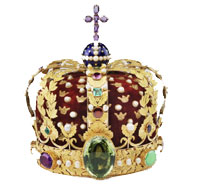
Chief amongst the royal regalia of Norway is the King’s Crown: made for King Carl Johan in 1818 by goldsmith Olof Wihlborg of Stockholm. This colourful golden corona clausa is lavishly set with gems; foremost is a large green tourmaline, numerous amethysts, chrysoprases and pearls are accompanied by an emerald, a ruby, a topaz, an alexandrite and an Opal. Intricate gold work surrounds the gems in the form of wreaths of oak leaves and vines of strawberry leaves. The gem laden yellow gold contrasts magnificently against the red velvet lining and the Latin cross atop the blue enameled orb at the crowns crest.


mosaic-imperial-table
This striking, gilt-bronze centre table (marble topped with a lapidary relief bouquet) originally placed in the Golden Drawing Room in the Winter Palace, the main residence of the Russian Imperial family in St. Petersburg. Commissioned for Empress Alexandra Fedorovna (1842), presented to Grand Duchess Maria Aleksandrovna, future Empress Maria (1844), sold at Bonhams for £916,000 on December 1st 2010. Reflecting the legendary opulence of the Russian Empire, the table top depicts a bouquet of flowers in a range of materials, from Opal, to coral to onyx and turquoise. This surrounded by a lapis lazuli Greek key border, the gilt-bronze surround with a frieze of cartouches, on a foliate stem and tri-form base mounted with swans, on a scrolling foliate frieze and acanthus cast feet. Exceeding the pre-sale estimate of £150,000 – 200,000 by over four times. This important historical piece was made by the Imperial Lapidary Factory in Peterhof, designed by Joseph August Satory (1803-1868), bronze mounts by Nichols and Plincke English Shop, 1842.

Imperial presentation ring hallmarks 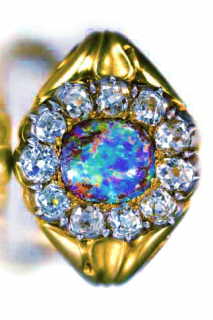
Imperial Boulder Opal presentation ring
This Imperial presentation jewelled gold ring, was made in St Petersburg, 1856. Centred with an Opal within circular-cut diamonds, the inside of the shank engraved: ‘Présenté par I.M. L’Empereur de toutes les Russies à Henry Bradbury 1857’, with maker’s mark A.P. or A.B. in Latin. Provenance: The engraved inscription presumably refers to the great English naturist, Henry Bradbury (1831-1860), whose work, The Ferns of Great Britain and Ireland (1855), was well-known in European Courts. Bradbury’s Opal ring was given him by the Russian Emperor under the Imperial Award System.

At the end of the nineteenth century some grande dames, but mostly women of the theatre and courtesans were attracted by the bizarre and the seductively twisted new style of jewellery. Above all it was the snake theme that fascinated the fin de siècle, which was attracted by its evil portents. It formed the chief motif of the Fouquet bracelet made in 1906 after a drawing by Czech Art Nouveau artist Alphonse Mucha for actress Sarah Bernhardt. Bernhardt wore it in her stage role as Cleopatra. The gold bracelet and attached finger-ring feature Opals accompanied by enamel, rubies, emeralds and diamonds.

The famous French jewellery houses of the nineteenth and twentieth centuries; Lalique, Fouquet, Vever, and those still operating in Paris today Cartier, Van Cleef & Arpels, Mauboussin, Marchak and the newest entrant Dior have all featured opal in their designs. The stones were and are still often selected and cut by in-house lapidaries.

Cartier made two pearl necklaces with opal and diamond clasps for the late Barbara Woolworth Hutton. One with two-rows of golden pearls and a multi-red coloured opal which she often wore with her fabulous ruby and diamond tiara. The other was an important strand of pearls once worn by Queen Marie Antoinette of France and now sporting a beautiful Black Opal (pictured).
At the Musee d’Orsay in Paris can be seen a magnificent objet d’art, a carved Boulder specimen c.1900 depicting ‘A Pantheon of gods seated in the clouds above Mount Olympus’.
A 77 carat Opal having belonged to Louis XVIII is kept in the National Museum of Natural History in Paris.
The Musée de Minéralogie, Paris, possesses a very fine Opal carved into a bust of Louis XIII’s likeness as a child.

Opal matrix Chalice 
opal_encrusted__urn
This stately chalice is carved from Opal matrix and the urn and several others like it are decorated with Hungarian Opals, they are on view at the Schatzkammer Museum in Vienna, Austria. Such vessels have been consecrated and used as religious objects by Roman and Byzantine aristocracy.
Other opal bearing articles worthy of mention include a collection of rings at the Schatzkammer Naturhistorisches Museum in Vienna and a necklace belonging to Princess Isabella of Hungary held at the Nemzeti Muzeum in Budapest.
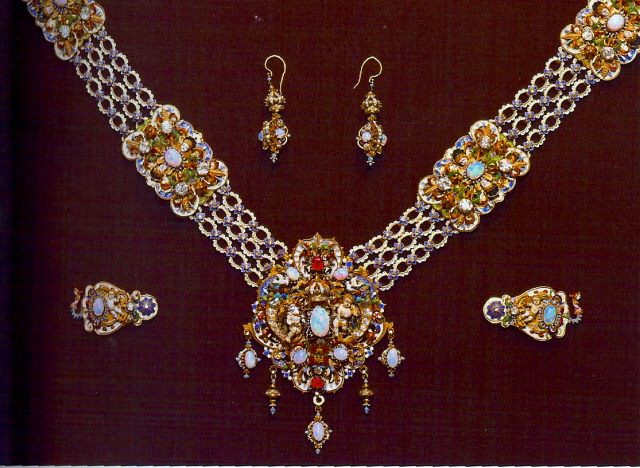
This decorative parure (matched set) was a gift from the city of Budapest to Princess Stephanie of Belgium on the occasion of her marriage to Crown Prince Rudolph on the 10th of May, 1881. After the death of Archduke Rudolph, his widow remarried and returned this parure to the imperial treasury in Vienna. Created by the Egger Brothers of Hungary and now housed at the Schatzkammer Museum of Art History in Vienna; Princess Stephanie’s (1864-1945) collection includes belts, bracelets, eardrops, headpins, necklaces and no fewer than ten Opal brooches.

At the British Museum © is an Opal cameo circa 1900 attributed to Wilhelm Schmidt an English carver of German origin. Portraying a profile head of a helmeted warrior, possibly Minerva, set in enamelled gold with a border of dots and fretwork pattern in white and blue enamel, flanked by silver leaves set with diamonds. This exquisite cameo is marked on the reverse and presented in the original case.
Schmidt carved his cameos from the newly discovered Boulder Opal variety, utilizing the matrix of the rough Opal for the ground colour and relief.

The Calouste Gulbenkian Museum in Lisbon, Portugal is the legacy of oil tycoon Calouste Gulbenkian. Gulbenkian was one of the world’s richest men; he assembled during his lifetime one of the most important private collections of art, recognized by its diversity and quality. Whether it be coinage, paintings or sculpture, jewelry or ceramics, Gulbenkian acquired only masterpieces.
Calouste Gulbenkian commissioned 146 jewelled artworks by Rene Lalique between 1895-1910. Lalique’s creative imagination and his preoccupation with beauty saw him select Opals as his gemstone of choice repeatedly in dozens of these jewels. This is an unrivalled collection of works by one of the greatest figures in the history of art. Not only a representative set of the multifaceted work of Lalique, the collection is a testament to the vibrant colours, versatile qualities and mesmerizing effects of Opal.

Close-up of the ‘Swan’ collar containing 9 Opals & 9 such links by Lalique 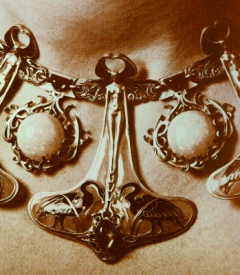

lalique opal bracelet

The ‘Butterfly’ also known as the ‘Red Admiral’, this famous Lightning Ridge Black Opal of 51 carats was set by Percy Marks jewellers of Australia who sold it in 1930. Marks since resold it to an eminent Scottish collector and it remains in the family collection. Roughly the shape and colour of the British Red Admiral butterfly, it was found in 1920. The exact field of origin remains a mystery, either the diggings at New Rush or Phone Line, not far from the discovery site of ‘Pride of Australia’ and ‘Empress’ stones. The ‘Butterfly’ was given supreme pride of place by Ted Murphy, one of the best judges of opal at the time.

A 203 carat Andamooka Crystal Opal and diamond necklet with matching earrings were presented to Queen Elizabeth II by the South Australian government to mark the occasion of her first visit to Australia in 1954. The rough stone which became the ‘Andamooka’ Opal, also known as the ‘Queen’s Opal’, was procured and cut by Altmann & Cherny.
Among the Royal collection of Jewels at Sandringham House are many pieces featuring Opals. Some are the work of the famous Russian jeweller Faberge whose workshops also carved and polished the gems they set; many in the likeness of animals, fish, birds, dogs and cats, a use for which Opal is well suited.

A large silver cigar box designed by famous British Arts & Crafts jeweller Archibald Knox for Arthur Lasenby of Liberty & Co. resides in London’s Victoria and Albert Museum. A large Boulder Opal takes pride of place on the lid of this Celtic Revivalist masterpiece which dates to the first decade of the twentieth century.
The Cartier Collection

Kingfisher 1960, Black Opal, ruby, sapphires & diamonds 
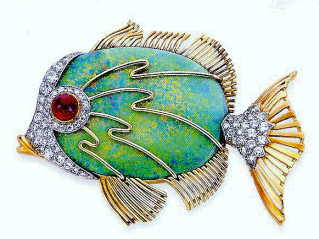
At the heart of the House of Cartier’s heritage policy since 1989, the Cartier Collection includes more than 1,300 pieces, acquired at auction and from private individuals. The collection has been displayed in major retrospectives at internationally renowned museums. Catalogued using Cartier’s own archive documents, it illustrates the changes in design styles and techniques in the Maison’s creations. Several important pieces in the collection, dating from the 1930’s to the 1960’s, reveal an affinity with Opal.

In 1967 internationally renowned sculptor, silversmith and jewellery designer Stuart Devlin started making unique decorative Easter eggs for which he is well known; the egg he made in 1974 contained an Opal mosaic and is a renowned objet d’virtu. Devlin gifted his decoratively jewelled eggs to his patrons, Her Majesty Queen Elizabeth II amongst them.